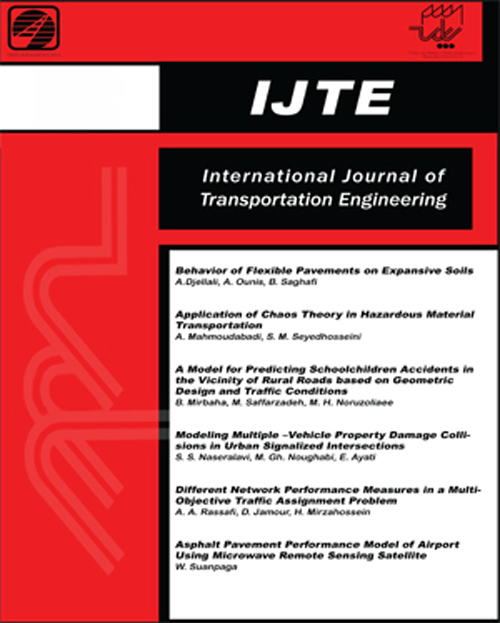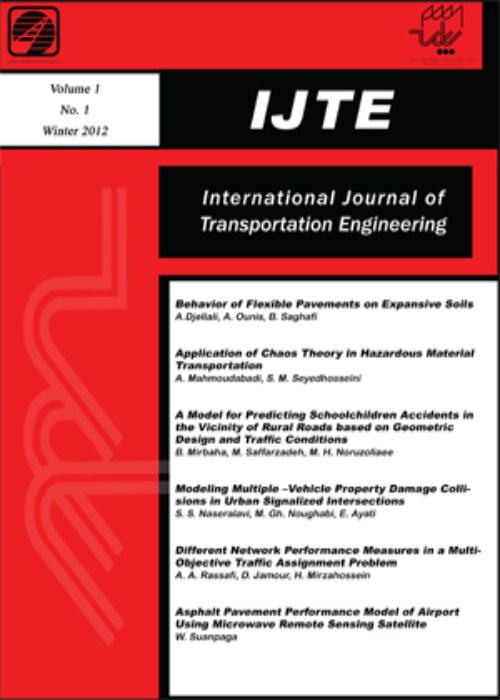فهرست مطالب

International Journal of Transportation Engineering
Volume:3 Issue: 2, Autumn 2015
- تاریخ انتشار: 1395/02/10
- تعداد عناوین: 6
-
-
Characterization of Bitumen Mixed with Plastic WastePages 85-91Plastic (Polyethylene Terephthalate, PET) is now used as packaging material for a whole range of consumer products in addition to carbonated beverages. Although plastics are very useful product, but the disposal of these wastes has become a problem and is of great concern, particularly in our country. One of the solutions to the disposal of plastic wastes is recycling it into useful products such as it may be used in bituminous (asphaltic) pavements construction, resulting in reduced permanent deformation in the form of rutting of the pavement surface. The present study discusses in detail about the effect of PET on various engineering properties of bitumen. The PET waste was added in the bitumen from 2 to 14% and various tests such as penetration, ductility, softening point, viscosity, flash and fire point and stripping tests were performed for the characterization of plain bitumen and PET modified bitumen. The most effective percentage of Polyethylene Terephthalate (PET) waste was obtained between 10 to 12% by weight of the bitumen. The results of the study indicated that the modified mixture possessed better performance as compared to the non-modified bitumen. The experimental results were also authenticated by conducting Scanning Electron Microscopy (SEM) on the most effective percentages mixtures. It is observed that the addition of PET waste in the bitumen improves its engineering properties such as ductility, penetration, softening point and viscosity values by 32.43%, 14.56%, 26%, and 34% respectively. It has also been observed that addition of 12% PET waste results in zero percent stripping even after 48 hours.Keywords: bitumen, characterization, PET, SEM
-
Pages 93-107This paper presents an evolutionary algorithm for recognizing high and low crash road segments using Genetic Algorithm as a dynamic segmentation method. Social and economic costs as well as physical and mental injuries make the governments perceiving to road safety indexes in order to diminish the consequences of road accidents. Due to the limitation of budget for safety improvement of all parts of the road, the road segments with more accidents should be recognized for safety budget assignment. So, considering this fact it's important to identify the segments with high and low number of accidents to optimize the road safety program. In this study, a novel chromosome coding method and a fitness function which are consistent with Genetic Algorithm are proposed. The proposed methodology is also validated by using two mathematical parameters so that the results confirm that the proposed modeling works properly. Afterward, the proposed dynamic segmentation method is compared with the other static segmentation methods along 51 km of ShahroodSabzevar highway. The proposed method may have more advantages comparing to static segmentation methods for all of the performance indexes which were considered in this study. The proposed method has a variance about two times higher than the one for accident density in comparison with the other static segmentation methods. About 62% and 34% improvement is achieved in average of segments accident density and total segments density respectively in comparison with the other fixed methods.Keywords: genetic algorithm, dynamic segmentation, road accident segments
-
Pages 109-123The necessary electricity of the workshops and buildings (W&Bs) located at the metro depot are provided by lighting power substation (LPS). To transmit electricity between LPS and W&Bs, some trenches should be dig and the requisite cables should be located in the trenches. This paper presents a new mixed integer linear programming (MILP) long-term decision model to find the best cable trench route between LPS and W&Bs and also the location of all W&Bs and LPS are fixed. In this problem, the objective is to minimize (1) used cables cost, and (2) trench digging cost. It should be considered that there exist many cases in which the minimum either used cables or trench digging does not result in minimum total cost. Therefore, in optimum solution, a tradeoff between these objectives should be achieved. Finally, the proposed model is applied to a real case study at the metro depot in Iran and the optimum solution is analyzed.Keywords: Cable trench problem, lighting power substation, metro depot, optimization
-
Pages 125-141Travel demand is well announced as a crucial component of transportation planning. This paper aims to develop a direct demand model, denoting a more acceptable abstraction of reality, for intercity passengers in daily work and leisure trips in Tehran province. The model utilizes combined estimation across the data source, collected in 2011, of travelers originating from the city of Tehran and heading toward two destination clusters: intra-province and inter-province. The paper sketches a way to predict simultaneous choice of departure time and travel mode under the influence of zonal (origin, destination, and residence), individual and household socio-demographic, and trip-related variables. The time frame for analysis of departure time is [5-19] and available modes are auto, taxi, bus, and metro. Multinomial Logit (MNL) and Nested Logit (NL) models as behavioral models are selected from discrete choice family to provide appropriate direct demand structure. Besides, the paper discusses Independent Irrelative Alternative (IIA) assumption of the models and demonstrates choice order of NL; Travelers choose departure time prior to mode at first level and then decide on mode at second level. Finally, travel demand elasticity and marginal effect with respect to travel time, age, and auto cost are also highlighted.Keywords: Direct demand, departure time, mode, multinomial logit, Nested Logit
-
Development of Models for Crash Prediction and Collision Estimation- A Case Study for Hyderabad CityPages 143-150Road traffic crash is a cause of unnatural death and occupies fifth position in the world as per WHO records. Road crashes in India are alarming in situation while road safety is professionally lacking and politically missing. Hyderabad city, the capital of newly formed Telangana State occupies sixth position in occurrence of road crashes. An attempt is made to understand which model is suitable for road crash prediction and estimation of collision type which is influencing road crashes in the city. A retrospective observational study was conducted in the city of considering factors as roadway geometrics, traffic data and type of collision. Regression models like Multiple Linear Regression, Poisson Regression, Logit Model and Multinomial Logistic Model are considered for arriving crash prediction models. The suitability of model is based on R2 and chi-square test. It is observed from the analysis through comparison of above model; Logit model has an R2 of 0.7 and is significant for chi-square test. Shoulder condition is an affecting factor for non-fatal crashes in the city which is ascertained by Logit model. Further analysis is also carried for arriving on type of collision influencing on road crashes. It is observed from the results that sideswipe is more significant for road crashes.Keywords: Road crash, collision, regression models
-
Pages 151-164Unbound aggregates are the most common type of materials used for construction of the base layer of flexible pavements in Iran and worldwide. Due to the lack of binder, the performance of the compacted unbound aggregates is highly dependent on the properties of the gravel (particles remaining on sieve 4.75mm, sand (particles passing sieve 4.75mm and remaining on sieve 0.75mm), and fines (particles passing sieve No. 200) fraction of the mixture. As the bearing capacity and permeability are the main properties influencing the performance of the base layer; in this research, the effects of the angularity of gravel and sand, and the content and plasticity of fines on the bearing capacity and permeability of the compacted unbound aggregates have been investigated. The bearing capacity of the materials in dry and saturated conditions has been measured using CBR test, and the permeability has been measured using constant head permeability test method. The results showed that the CBR of the compacted mixture decreases with decreasing the percentage of angular sand and gravel in the mixtures. The strength of the mixture was shown to be optimum at a certain amount of fine content and decreases with increasing the plasticity of the fine fraction. It was found that the saturated CBR of the mixtures with non-plastic fines is higher than that of the dry CBR. It was also found that the angularity of the sand is more effective than the angularity of gravel on the CBR. The permeability of the mixtures is shown to increase with decreasing the angularity of the gravel and sand fraction in the mixture.Keywords: Base, unbound aggregate, permeability, CBR, angularity, plasticity


